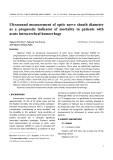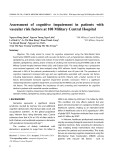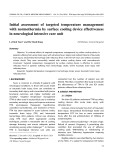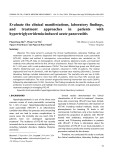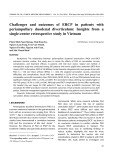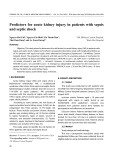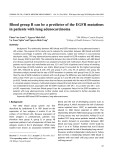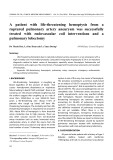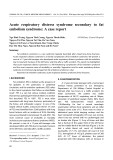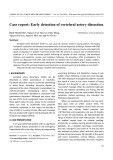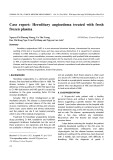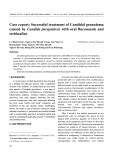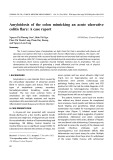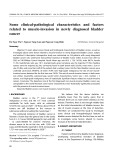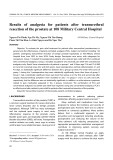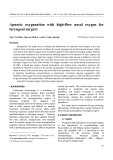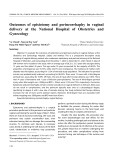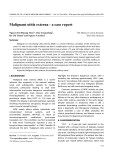
HUE JOURNAL OF MEDICINE AND PHARMACY ISSN 3030-4318; eISSN: 3030-4326HUE JOURNAL OF MEDICINE AND PHARMACY ISSN 3030-4318; eISSN: 3030-4326
64 65
Hue Journal of Medicine and Pharmacy, Volume 15, No.2/2025 Hue Journal of Medicine and Pharmacy, Volume 15, No.2/2025
*Corresponding author: Lê Hoàng Minh Quân; Email: lhminhquan@ump.edu.vn
Received: 16/10/2024; Accepted: 10/3/2025; Published: 28/4/2025
DOI: 10.34071/jmp.2025.2.10
The effect of auricular acupuncture (AT4) when combined with electro-
acupuncture in recovery cerebral infarction: A randomized trial
Ha Tuong Phong1, Nguyen Thi Son 2, Le Hoang Minh Quan2*, Nguyen Hoai Thuong 2,
Nguyen Thi Ngoc Nghia2, Ho Thuc Anh2, Nguyen Thi My Phuong2, Le Ngoc Bao3
(1) Traditional Medicine Hospital of Ho Chi Minh City
(2) Faculty of Traditional Medicine, University of Medicine and Pharmacy at Ho Chi Minh City, Vietnam
(3) Binh Dinh Provincial Hospital of Traditional Medicine and Rehabilitation
Abstract
Background and Objectives: Cerebral infarction can lead to severe consequences. According to traditional
medicine theory, electro-acupuncture and ear acupuncture are some of the successful treatments for
rehabilitating the motor functions of paralyzed limbs. The goal of this study is to evaluate the efficacy of
combining ear acupuncture (AT4) with traditional electro-acupuncture to aid in the recovery of individuals
experiencing limb paralysis due to a brain infarction. Methods: Patients at the Traditional Medicine Hospital
in Ho Chi Minh City provided 108 samples for a clinical experiment. The research follows a randomized,
unblinded, and controlled design. The evaluation criteria include the number of rounds the patient puts into
the hole in 1 and 3 minutes, the time to walk 10 meters with support equipment, and the Barthel index (BI)
score in 4 weeks. Results: The number of rounds the patient puts into the hole in 1 minute and 3 minutes
increased, while the time to walk 10 meters with support equipment decreased. The difference from the
baseline demonstrated the effectiveness of acupuncture in general and presented the results of combining
acupuncture and ear acupuncture in particular. Compared to the two Groups, BI scores in the Treatment
Group improved more than in the Control Group with a statistically significant difference. No patient had any
adverse events during the study. Conclusion: Combining auricular acupuncture and electro-acupuncture can
improve motor rehabilitation in patients with cerebral infarction.
Keywords: Stroke recovery, AT4, auricular acupuncture, electro-acupuncture, Barthel index.
1. INTRODUCTION
Stroke is the second-leading cause of death
and the third-leading cause of death and disability
combined in the world [1]. Stroke includes cerebral
infarction, cerebral hemorrhage, and subarachnoid
hemorrhage. Post-stroke patients experience a
range of health issues including substantial motor
and sensory impairment, cognitive deficits, difficulty
swallowing (dysphagia), communication troubles,
pain in the shoulder on the affected side (hemiplegic
shoulder pain), and problems with bowel and urine
control (incontinence). Motor impairments in stroke
patients lead to deconditioning and decreased
degrees of independence [2].
Nowadays, a large number of people prefer
acupuncture therapy, a procedure that involves
minimal invasion, as a means of physical
rehabilitation. Multiple papers have evaluated the
efficacy of acupuncture in improving motor function
[3].
To begin with, acupuncture and electro-
acupuncture can bring remarkable benefits to
stroke patients during their rehabilitation through
five primary processes. These actions encompass
stimulating new neurons and cell growth in the
central nervous system. In addition, control of blood
flows in the areas that are affected by blood supply
reduction, preventing cell death in influenced brain
fields, regulating neurochemicals, and enhancing
poor long-term synaptic strength and memory after
a stroke [4].
Auricular acupuncture is a form of acupuncture
that stimulates specific acupoints on ear parts
according to the Chinese Ear Chart recognized by the
World Health Organization. It has been described
to support stroke survivors with dyskinesia, and
many scientists believe that stimulating the M1
area of the brain can be a key part of using auricular
acupuncture to help stroke patients with upper limb
dysfunction [5].
However, the mechanism of acupuncture and ear
acupuncture, with their effectiveness in improving
activity abilities after a cerebral infarction, have not
been addressed in depth. This study will investigate
whether combining auricular acupuncture (AA)
and electroacupuncture (EA) could enhance motor





